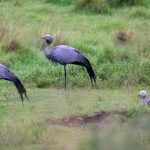
My wife and I reached southern Spain’s Costa del Sol region on October 19th, staying until the 4th of November. Spain, coming out of a multi-year drought, had begun receiving promising early season rains. And then, on October 29th, these rains turned torrential, leading to Spain’s worst-ever natural disaster. To date when I’m writing this, 217 deaths have been reported.
We, fortunately, were staying in Algeciras, a city which experienced no major damage from this week-long storm. The same could not be said for certain towns uphill from Málaga, the city into which we had flown, Jerez de la Frontera, which we had visited only two days before, and especially, the more eastern province of Valencia.
I feel incredibly shallow and insensitive writing this, but this storm also really messed up my birding. But, this being a site for birders, that is what I must write. Although our trip was work-related, I had had high hopes of also experiencing, for the second time, one of the world’s great avian migration spectacles, as hundreds of thousands of raptors and storks fly across the comparatively narrow waters of the Strait of Gibraltar. (That is a view across the Strait, with Africa in the background, at the top of this post.) But even before the storm revved up, wild winds meant that no raptors were to be seen on the mornings I had available. So I had to content myself with much smaller numbers of much smaller birds, flitting around their Andalucian home.
The very morning of the climate catastrophe, I headed off to the Cazallas Soaring Bird Observatory, just in case there was some raptor action. No such luck. Then I proceeded to the island of Tarifa, Europe’s southernmost point, in the hopes of seeing some seabirds flying by. Unfortunately, the already worsening weather conditions were accompanied by my discovery that you can’t get on the island without an appointment, which I did not have.
Still, the site gave me some nice views of Northern Gannets, as well as the surprise of some strongly marked shorebirds I did not initially recognize. It seems odd that these 12 birds could be lifers for me, as the Ruddy Turnstone is a cosmopolitan species that I could well have seen in coastal Mexico or California. But I had never done so, and lifers they were.



I liked this photo of Great Cormorants and Yellow-legged Gulls, as the African mountains, known as one of the Pillars of Hercules, perfectly framed the Spanish rock on which they stood.

Spanish Yellow-legged Gulls can be quite orderly.

I then moved on to the mouth of the Palmones River in nearby Algeciras, where I saw a larger number of species. I enjoyed managing a nice picture of a Common Chiffchaff. (Which is an amusing name for us Americans.) My photo of a Zitting Cisticola was not as pleasing, but the bird made up for it with its even more amusing name.


As always, this site offered a good number of White Storks.

By the end of the day, my grand total for birds of prey was one Eurasian Kestrel in Cazallas, another one in Palmones, and a single Booted Eagle and one Black Kite in Palmones.
Four days later, we drove north from Tarifa to the airport at Málaga, prior to flying south to Marrakesh in Morocco. The weather was windy, as always in Tarifa, with clouds covering the hilltops. Suddenly, some 40 massive Eurasian Griffons flew over a ridge at the Mirador del Estrecho (Strait Viewpoint) as we drove up. I quickly pulled the car over to snap photos as they gradually flew higher, until they disappeared into the clouds. Fortunately, the Viewpoint has a gift shop, so my wife had no problem with the unexpected stop.














Too much rain or not enough (https://www.10000birds.com/the-rain-in-spain-stays-mainly-in-the-plain.htm?doing_wp_cron=1731085613.1364190578460693359375) two sides of the same coin